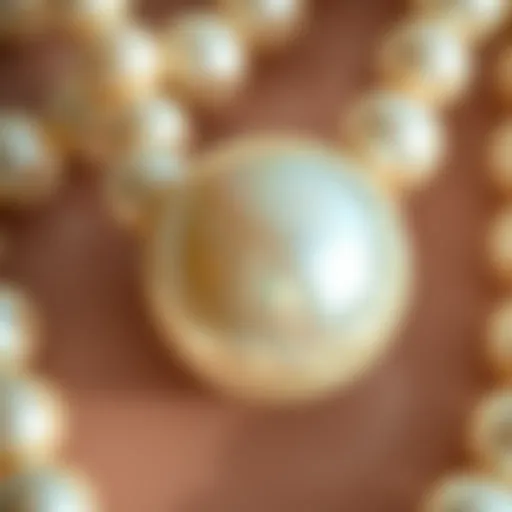Techniques to Effectively Remove Tarnish from Jewelry
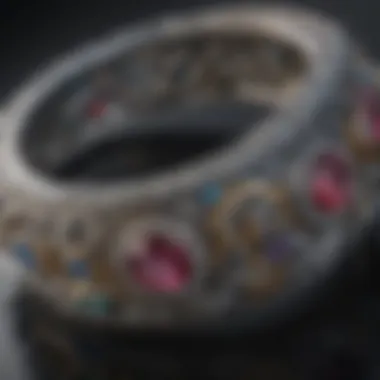

Intro
Tarnish on jewelry can be a real thorn in the side for both casual wearers and avid collectors alike. It diminishes the shine and beauty of your precious pieces, not to mention the frustration that comes with trying to restore them to their former glory. The reality is that tarnish is a natural occurrence, often a result of exposure to air, moisture, and other environmental factors. This article aims to explore effective methods for removing tarnish, while also delving into the underlying causes and implications for various metals and gemstones. This knowledge can empower you, as a jewelry owner, to maintain your pieces effectively, ensuring they look their best for years to come.
Gemstone Overview
Definition of Gemstones
Gemstones are naturally occurring, mineral-based substances that are prized for their beauty, rarity, and durability. Unlike ordinary minerals, gemstones undergo processes of crystallization and geological transformation that make them appealing in the world of jewelry. Most notably, they are cut and polished to enhance their aesthetic qualities, thereby transforming raw mineral into objects of art. Whether precious or semi-precious, gemstones play a significant role in adornment and symbolism.
Classification of Gemstones
Gemstones can be classified into two major categories: precious and semi-precious. Precious gemstones, like diamonds, rubies, emeralds, and sapphires, are sought after for their rarity and brilliance. Semi-precious stones, such as amethyst, garnet, and topaz, are also beautiful but more abundant.
- Precious Gemstones:
- Semi-Precious Gemstones:
- Diamonds
- Rubies
- Emeralds
- Sapphires
- Amethyst
- Garnet
- Topaz
- Turquoise
Understanding these classifications can be beneficial when addressing tarnish, as different gemstones might respond uniquely to restoration techniques.
"The understanding of gemstones goes hand-in-hand with the care they deserve. A well-cared-for gemstone can last a lifetime, telling a story through its wear and shine."
In the world of jewelry, the combination of tarnishable metals and gemstones demands a careful balance. For instance, while silver may tarnish easily due to sulfur exposure, gold does much better under similar conditions, often requiring less maintenance. Consequently, knowing how to deal with tarnishing effectively becomes essential for gemstone enthusiasts, collectors, and jewelry makers.
Through this guide, readers will not only acquire knowledge about removing tarnish, but also gain insights into practical care routines to keep their treasured pieces shining bright.
Understanding Tarnish
Understanding tarnish is crucial for anyone who cherishes their jewelry. It encompasses not just the aesthetic degradation of metal but also dives deeper into how the environment interacts with these cherished items. Knowing what tarnish is and how it forms can significantly enhance your ability to maintain and appreciate your jewelry.
Definition and Process of Tarnishing
Tarnish refers to the dulling or discoloration of metals, primarily seen in silver, due to a chemical reaction. This reaction often involves sulfur compounds found in the air or certain substances that come into contact with the metal. Over time, something as simple as wearing silver jewelry can initiate this process. The surface of the metal reacts with the elements, creating a thin layer of corrosion that affects the metal's shine and clarity. This change can be subtle at first but may become more pronounced if left unattended.
Most people might equate tarnish with dirt or grime, but it’s more about the chemistry at play. With silver, it’s primarily silver sulfide forming due to exposure. While some may think that tarnish could be cleaned up with a quick wipe, it often requires more care and proper techniques to not just clean but preserve the jewelry. Taking the time to understand how this process occurs is foundational for effective maintenance.
Common Metals Affected by Tarnishing
Not all metals tarnish alike, but several are especially prone to this issue. Common offenders include:
- Silver: The most notorious for tarnishing, silver can darken quickly, particularly if exposed to air or certain chemicals.
- Copper: Known for its green patina when tarnished over time, it also reacts with moisture in the environment.
- Brass: This blend of zinc and copper can tarnish, leading to an unappealing appearance.
- Nickel: Often used as an alloy, nickel can tarnish, especially when combined with other metals.
These metals not only lose their luster but can also become more susceptible to further corrosion if the tarnish is not managed properly. If you want to maintain the beauty of your jewelry, keeping an eye on what metals you own is essential.
Factors Influencing Tarnish Formation
Several environmental factors contribute to how quickly and severely tarnish forms. These include:
- Humidity: High moisture levels in the air will accelerate tarnishing. It’s simple; the wetter the air, the more likely tarnish will appear on your metals.
- Pollution: Sulfur and other chemical agents uplifted in the air can settle back onto jewelry and initiate tarnishing.
- Personal Chemistry: Every person has unique skin chemistry that can react with metals, leading to accelerated tarnishing.
- Storage Conditions: Improper storage, such as leaving jewelry unprotected in damp areas, can lay the groundwork for tarnish to develop.
"The environment you keep your jewelry in can play a large role in its condition, perhaps even more so than the jewelry itself."
By understanding these elements, you can better prepare your jewelry for longevity, tailoring your care and cleaning efforts to your specific collection and its needs. Digging deep into the mechanics of tarnishing affirms the necessity of proper care and will save owners time and effort in restoring beauty to their favorite pieces.
Assessing the Extent of Tarnish
Understanding the degree of tarnish present on your jewelry pieces is crucial for effective restoration and maintenance. Before diving into different cleaning techniques, it’s essential to evaluate the tarnishing to determine the most appropriate remedy. Ignoring the extent of tarnish can lead to improper handling, which may cause more harm than good. Moreover, an accurate assessment can allow for the identification of patterns in tarnishing, helping you implement more targeted prevention strategies.
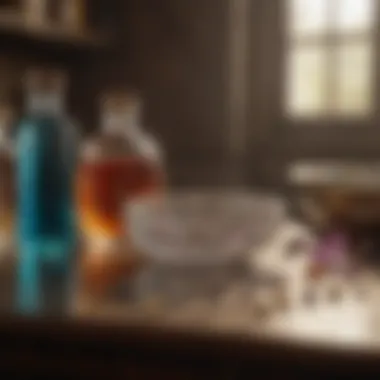

A well-rounded assessment lays the groundwork for what follows in your jewelry care journey. It’s about catching tarnish before it becomes a bigger issue, saving you time and effort in the long run.
Visual Indicators of Tarnish
Tarnish often reveals itself in multiple ways, and recognizing these signs can be half the battle in effective jewelry maintenance:
- Discoloration: This is the most obvious marker. Pieces can take on a dull, greyish, or even greenish sheen, signaling tarnish buildup. Silver items are particularly prone to this very common symptom.
- Uneven Coloring: If your jewelry has multiple metals or stones, you’ll often notice patches or spots that look different from the rest of the piece. This uneven tone can signify that some areas have encountered more contamination than others.
- Texture Changes: When tarnishing progresses, you may also begin to notice texture alterations, such as rough or pitted surfaces.
These visual cues can help you decide whether a simple cleaning might suffice or if more intensive restoration is on the horizon. Identifying these signs early could prevent further complications of damage.
Testing for Tarnish
Sometimes, tarnish can play coy, hiding behind a seemingly pristine exterior. To truly identify if tarnish is at play and how deep it goes, a few tests can help in making that determination.
- The Water Drop Test:
- The White Cloth Test:
- The Baking Soda and Water Test:
- Place a small drop of clear water on the jewelry piece. If the drop remains smooth and bead-shaped, the object likely doesn't have tarnish. However, if the water spreads out or forms a matte appearance, tarnish may be present.
- Gently rub a clean white cloth against a less visible area of your jewelry. If the cloth catches color or grey streaks, that's a telltale sign of tarnish.
- Create a paste using baking soda and water, apply it to a small, inconspicuous part of the item, and wait a few minutes. If discoloration occurs on the paste, there's likely tarnish causing the issue.
Important: Always proceed with caution while performing these tests, especially on delicate items or those with sensitive stones.
By evaluating tarnish through visual indicators and tests, one can determine the most effective course of action to restore jewelry to its former radiance.
Prevention Strategies for Tarnish
Taking steps to prevent tarnish can save jewelry lovers a lot of time and hassle. The old saying goes, "an ounce of prevention is worth a pound of cure," and this couldn't be truer in the realm of precious metals and fine jewelry. By being proactive, you not only keep your pieces looking polished and professional but also extend their lifespan. Understanding how tarnish forms and what can be done to minimize its occurrence helps in maintaining the integrity and beauty of jewelry over time.
Storage Solutions for Jewelry
Storing jewelry properly is a fundamental aspect of tarnish prevention. Improper storage can lead to unnecessary exposure to elements that accelerate tarnishing.
- Use Anti-Tarnish Pouches or Cloths: These specialized pouches or cloths are infused with chemicals that reduce oxidation, a common factor in tarnishing. By storing individual pieces in these, you can significantly slow down the tarnishing process.
- Avoid Humidity: Moisture is a major culprit that contributes to tarnish formation. Keeping jewelry in a dry environment is crucial. Consider using silica gel packs in your storage area to absorb excess moisture.
- Individual Compartments: If possible, store pieces in individual compartments. This way, you avoid scratches and the chance of more reactive metals coming into contact with each other. For example, separating silver items from copper can reduce the risk of tarnishing.
- Cool, Dark Places: Jewelry should ideally be kept away from direct sunlight and heat sources. Consider assigning a drawer or a dedicated box that’s away from lights and fluctuations in temperature.
Routine Care and Maintenance Practices
Establishing a regular routine for jewelry care is just as essential as proper storage. A little consistent attention goes a long way in keeping tarnish at bay.
- Regular Cleaning: It's advisable to clean your pieces every few months. Simply using a soft cloth to wipe down jewelry after each use can prevent the buildup of tarnish-causing compounds. Gold and silver can always benefit from a gentle wipe.
- Avoid Exposure to Chemicals: Everyday products like perfumes, lotions, and household cleaners can cause tarnish or damage to jewelry. Always put on jewelry after applying such products and remove it before engaging in activities like cleaning or swimming.
- Professional Checks: If you own particularly valuable or intricate pieces, occasional inspections by a professional jeweler can be beneficial. They can perform detailed cleanings you might not manage at home and catch early signs of tarnish before they become a larger problem.
- Know Your Jewelry: Understand the specific care required for different materials. For example, pearls and opals need special attention as they can be more sensitive to environmental factors compared to sturdier metals.
"Jewelery maintenance is not just about beauty; it speaks to the respect for the craft and stories behind each piece."
DIY Methods for Removing Tarnish
When it comes to maintaining the luster and shine of your cherished jewelry, taking the DIY approach can be both cost-effective and satisfying. This section delves into various home remedies that are not just simple but also effective in combating tarnish. DIY methods allow jewelry enthusiasts to handle their pieces with care while knowing exactly what ingredients they use. These methods are particularly appealing for those who prefer a hands-on approach to jewelry care, as they can save time and can be more gentle on precious metals and stones compared to harsh commercial cleaners.
Baking Soda and Water Paste
One of the most popular DIY methods for tackling tarnish involves the humble baking soda. To create a simple paste, start by mixing three parts of baking soda with one part of water until you achieve a thick consistency. This paste acts as a gentle abrasive when used to clean tarnished jewelry.
- Apply the Paste: Use a soft cloth or a sponge to apply the paste to your tarnished jewelry. Focus on the areas that show the most discoloration.
- Gently Rub: With a light touch, gently rub the jewelry in circular motions. This helps lift the tarnish without scratching the surface.
- Rinse Thoroughly: After cleaning, be sure to rinse the jewelry under lukewarm water to remove any residue. Avoid using hot water, as it may affect certain gems.
- Dry with Care: Finally, dry your jewelry with a soft, lint-free cloth to prevent water spots.
Baking soda’s slight abrasiveness works wonders, yet it remains gentle enough for most pieces, making it a popular choice among DIYers.
Vinegar and Salt Method
Vinegar has long been touted as a household miracle worker. Its natural acidity makes it an effective remedy for tarnish. When combined with salt, you can amplify its tarnish-fighting capabilities. Here's how to utilize this method:
- Create the Mixture: In a bowl, combine half a cup of white vinegar with two tablespoons of salt. Stir until the salt dissolves completely.
- Submerge the Jewelry: Place your tarnished jewelry within the mixture and let it sit for about two to three hours. Some pieces may require less time, so check periodically.
- Rinse and Dry: Once the tarnish has lifted, rinse the jewelry thoroughly under cool water and dry it using a soft cloth.
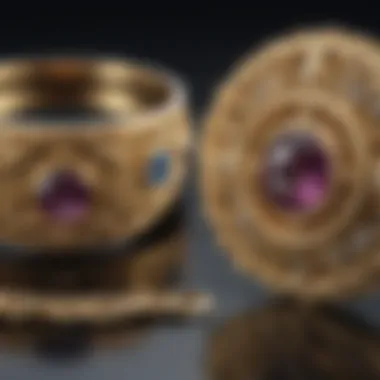

It’s important to note that this method may not be suitable for all jewelry types, particularly those containing porous stones or delicate settings. Always conduct a patch test first, if uncertain.
Toothpaste as a Cleaning Agent
Surprisingly enough, toothpaste can also serve as an effective DIY cleaner for tarnished jewelry. It's essential to choose a non-gel, non-whitening toothpaste to avoid abrasive ingredients that could scratch softer metals or gemstones. To clean with toothpaste:
- Apply Toothpaste: Squeeze a small amount of toothpaste onto a soft cloth or a toothbrush. Make sure the tool you use is clean to avoid transferring dirt.
- Gently Scrub: With gentle strokes, scrub the jewelry, paying special attention to the tarnished areas. Avoid using too much pressure.
- Rinse Well: Rinse your jewelry thoroughly under lukewarm water to ensure all toothpaste remnants are gone.
- Pat Dry: Use a soft cloth to dry your jewelry and restore its shine.
Toothpaste can be a surprise ally in restoring the shine of jewelry, especially for quick fixes.
Commercial Products for Tarnish Removal
When it comes to tackling tarnish, employing commercial products can transform the task from a daunting chore into a much quicker and efficient process. These products are typically formulated to target specific types of tarnish found on various metals and have been designed with ease of use in mind. They come with user-friendly instructions, which is a relief for anyone who isn't particularly handy with cleaning solutions.
Metal-Specific Cleaners
Metal-specific cleaners cater to the diverse materials jewelry is made from, such as silver, gold, or copper. Each metal interacts with tarnish in unique ways, and using the wrong cleaner could cause more harm than good. For instance, silver tarnish removers often contain thiourea, which can effectively restore shine but might damage softer gemstones that are set in silver. Gold, on the other hand, requires a milder approach. Products specially formulated for gold often include gentle abrasives that lift tarnish without scratching the surface.
Moreover, using these precise formulas can save wearers from making costly mistakes. Here are some examples of metal-specific cleaners in the market:
- Hagerty Silver Polish: Well-regarded for its effective silver cleaning and tarnish prevention abilities.
- Goddard's Long Term Silver Care: Known for its ability to shield silver jewelry against tarnishing effects for up to ten months.
- Connoisseurs Delicate Jewelry Cleaner: Ideal for plated and porous metals, offering a safe yet effective cleaning without risking damage.
Ultrasonic Cleaners and Their Use
Ultrasonic cleaners are a game changer in the realm of jewelry maintenance. These devices work by sending high-frequency sound waves through a cleaning solution, creating microscopic bubbles that implode, effectively agitating and loosening dirt and tarnish. The beauty of ultrasonic cleaners is their ability to reach even the tiniest nooks and crannies that are often neglected with traditional cleaning practices.
However, while highly effective, these machines shouldn't be viewed as a one-size-fits-all solution. Not all jewelry is suitable for ultrasonic cleaning. For instance, certain porous stones, like opals or turquoise, can be damaged, as well as any items with glued components or intricate settings. It's crucial users follow manufacturer guidelines and, when in doubt, consult with a professional or the manufacturer about the product's compatibility.
Advantages of using ultrasonic cleaners include:
- Efficiency: Cleans multiple pieces simultaneously, saving time.
- Thoroughness: Reaches areas that manual cleaning might miss.
- Time-Saving: Shortens the cleaning process, letting you get back to enjoying your jewelry sooner.
While exploring the options in commercial products for tarnish removal, always consider factors like material safety, ease of use, and potential impact on the longevity of your treasured items. Investing in the right cleaning products can preserve your jewelry's beauty while also enhancing its lifespan.
Special Considerations for Delicate Items
When it comes to jewelry, not all pieces are created equal. Some items are intricate and delicate, crafted with care and often housing fragile stones. Understanding how to care for these sentimental treasures is vital. Tarnish removal techniques that work for robust metals may not be suitable for delicate items. Thus, it’s crucial to address these special considerations to maintain their beauty and integrity.
Cleaning Antique Jewelry
Cleaning antique jewelry requires a gentle touch, as it can be particularly sensitive. These pieces often feature materials and construction methods that don’t fare well under harsh conditions. For example, old soldering may become weak or brittle. Cleaning solutions that work for modern jewelry might tarnish the luster of historical gemstones or strip the metal of its patina.
Here are some thoughtful approaches to cleaning antique jewelry:
- Use a Soft Cloth: Instead of using brushes or scrubbing pads, a microfiber cloth can gently lift tarnish without scratching the surface.
- Soak in Mild Soaps: Create a mixture of warm water and a few drops of gentle soap. Let the jewelry soak for a short time before gently wiping.
- Avoid Chemicals: Steer clear of abrasive cleaners or those containing ammonia. These can do more harm than good.
Even gentle methods can be risky, so consider testing on less visible parts if possible. Alternatively, you may opt to consult a professional who specializes in antique restoration, ensuring your precious heirlooms continue to dazzle for generations to come.
Handling Stones and Settings
When dealing with stones and their settings, subtlety is the name of the game. Different stones require unique approaches. Soft stones like turquoise or opal are particularly sensitive to chemicals and heat. Here are some careful handling tips:
- Assess the Stone Type: Knowing the hardness of the stone is key. Use tools and methods that are appropriate for that specific material.
- Remove Loose Dirt: Before any cleaning method, gently brush off loose dirt with a soft brush.
- Rinse Carefully: If rinsing is necessary, ensure you don’t expose stones to high-pressure water.
Remember, when in doubt, it's always safer to consult with a jeweler who has experience with delicate items.
Taking the necessary precautions in caring for delicate items in your jewelry collection can make a world of difference. A little mindfulness goes a long way in preserving the beauty and value of these precious pieces. Consider regular professional check-ups to catch any potential issues early, keeping your jewelry not just clean but breathtakingly beautiful.
Long-Term Care for Jewelry
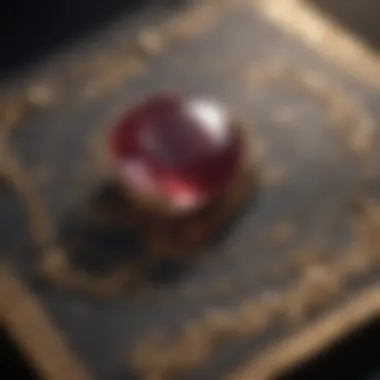

Taking care of jewelry isn't just a short-term effort; it’s about ensuring that precious pieces remain in gorgeous condition for years. Long-term care for jewelry goes beyond cleaning techniques; it's about establishing a routine that protects not only the metal but also any embedded stones. This is crucial because tarnishing and wear can take their toll over time, often leading to irreversible damage. By adopting a comprehensive long-term care strategy, jewelry enthusiasts can preserve the aesthetic and monetary value of their cherished items.
Key Benefits of Long-Term Care:
- Preservation of Value: Regular maintenance helps in retaining the intrinsic worth of the jewelry, especially for antiques or designer pieces.
- Aesthetic Appeal: Well-maintained jewelry sparkles and captivates; it draws the eye rather than repels it with tarnish or grime.
- Prevention of Damage: Small issues can snowball into bigger problems. Routine checks can catch loose stones or weak clasps before they become significant headaches.
Regular Inspection and Maintenance
In the realm of jewelry care, regular inspection and maintenance can feel a bit like visiting the dentist—unpleasant to think about, but absolutely necessary for long-term well-being. Taking the time to check your pieces periodically helps spot issues that might not be visible at first glance. A simple inspection can reveal tarnishing spots, loose fittings, or scratches that need attention.
When performing these checks, consider the following tips:
- Frequency of Checks: Aim for bi-monthly inspections for frequently worn pieces. If you have items that are mostly kept in storage, once every six months should suffice.
- Clasp Functionality: Ensure that clasps on necklaces and bracelets are working. An unnoticeable change could lead to the loss of an entire piece.
- Stone Security: Check if any stones are loose in their settings. Sometimes a gentle shake will help identify potential issues.
You might even want to jot down your findings in a journal. Knowing your jewelry's condition at a glance can be helpful.
Professional Cleaning Services
For those who take their jewelry seriously, enlisting the help of professional cleaning services can be a worthy investment. While DIY methods can work wonders, there are limitations, especially with intricate designs or valuable pieces. Professionals have specialized tools and solutions that can handle delicate materials without risk.
What to Consider When Choosing A Professional Service:
- Credentials: Look for jewelers or services with recognized credentials, such as memberships in professional associations.
- Customer Reviews: Word-of-mouth is powerful; check online testimonials and look for consistent positive feedback.
- Services Offered: Ensure that they provide specific cleaning for your type of jewelry. Some might specialize in antique or gemstone-specific cleaning.
- Inspection After Cleaning: A good service will also inspect your items post-cleaning to identify any additional needs for care or repair.
“Investing in regular professional care gives you peace of mind, knowing your jewelry is in the hands of experts.”
Ultimately, long-term care is about being proactive rather than reactive. Those fleeting moments of shine and sparkle you enjoy today can surely be safeguarded for tomorrow.
When to Seek Professional Help
Knowing when to seek professional help for tarnished jewelry can be crucial for maintaining the beauty and longevity of your precious pieces. While many tarnishing issues can be tackled at home using DIY methods, there are times when the expertise of a professional jeweler is essential. In this section, we will delve into the specific signs that indicate repair needs and offer guidance on choosing a qualified jeweler for delicate restorations.
Identifying Repair Needs
Identifying when your jewelry requires a professional touch can sometimes feel like deciphering a riddle. Key indicators include:
- Severe Tarnishing: If your jewelry is heavily tarnished, home remedies might not suffice. An overwhelming discoloration might demand specialized cleaning tools and techniques that professionals have.
- Structural Damage: Look for signs of damage such as twisted prongs, loose stones, or broken clasps. These problems might not be solved by simple cleaning.
- Complex Settings: If your jewelry features intricate designs or embedded stones, it's wise to get these pieces checked by professionals to prevent further damage during the cleaning process.
Remember, trying to force a solution could lead to more problems, like scratching or damaging the jewelry further.
Choosing a Qualified Jeweler
When you've determined that your jewelry needs professional care, the next step is selecting a qualified jeweler. This can be a daunting task, but there are a few pointers to keep in mind:
- Credentials and Experience: Look for jewelers who have relevant qualifications and demonstrable experience in jewelry repair. Check whether they have certifications, memberships to jewelry associations, or any accolades.
- Specialization: Some jewelers specialize in certain types of jewelry, such as antique or gemstone settings. Finding one that has specific expertise relevant to your needs can make a world of difference.
- Reviews and Recommendations: Don’t underestimate the power of word-of-mouth. Ask friends and family for suggestions, or check online reviews to gauge the satisfaction of previous customers. Websites like Reddit can offer candid opinions from fellow jewelry enthusiasts.
"The right jeweler is as essential as the jewels themselves. Trust matters, especially with something as precious as your jewelry."
- Consultation Service: A good jeweler will often offer a consultation before performing any work. This is your opportunity to discuss your concerns and get a feel for their expertise. Inquire about their cleaning methods, costs, and expected outcomes.
When you do find a jeweler you feel confident in, it brings peace of mind knowing that your treasures are in skilled hands. Investing in professional care, when needed, will ensure that your jewelry remains not just beautiful but also structurally sound.
Closure and Summary
In this comprehensive exploration of tarnish removal techniques, we emphasized the integral role of understanding tarnish, its causes, and methods to effectively restore the glow of your jewelry. Tarnish isn’t merely a cosmetic issue; it signifies reactions occurring on the metal surface, leading to the loss of luster and potential value over time. By being mindful of the chemical properties related to the metal in question, collectors and admirers alike can adopt appropriate care strategies.
Recap of Key Points
- Understanding Tarnish: Grasping the definition and process of tarnish is crucial. It's primarily caused by exposure to elements like sulfur, moisture, and oxygen.
- Assessing the Extent of Tarnish: Recognizing visual indicators such as discoloration or dullness helps determine the required cleaning method. A simple scratch test might reveal the core metal beneath the tarnish.
- Prevention Strategies: Adequate storage solutions and regular maintenance practices can significantly mitigate tarnish formation. Using airtight containers or anti-tarnish cloths can extend the life of your jewelry.
- DIY Methods: Tried-and-true methods using items like baking soda or vinegar may offer efficient and cost-effective cleaning alternatives.
- Commercial Products: Exploring specific commercial cleaners tailored for different metals can be an efficient choice, particularly for larger collections needing regular care.
- Delicate Jewelry Considerations: Vintage pieces or those with gemstones require specialized management to avoid damage during cleaning.
- Long-Term Care: Regular inspection and knowing when to rely on professional cleaning services can broaden the lifespan and preserve the beauty of your items.
Final Thoughts on Jewelry Care
Proper jewelry care goes beyond mere aesthetics; it becomes a cherished ritual. Just like you wouldn’t neglect your prized books or art, your jewelry deserves the same level of respect. Each piece often carries memories, whether tied to a loved one or a special occasion. Nurturing them through thoughtful maintenance not only preserves their intrinsic value but also ensures they can be enjoyed for generations to come.
"Jewelry takes on the personality of the person wearing it; it holds stories that echo through time."
Thus, adopting a vigilant approach, whether through routine cleanings or seeking expert advice when in doubt, is essential. Successful tarnish removal doesn’t just restore shine; it enhances the emotional resonance of your jewelry collection. By investing time in understanding these techniques, jewelry caretakers can cultivate a deeper appreciation for their treasured pieces.



